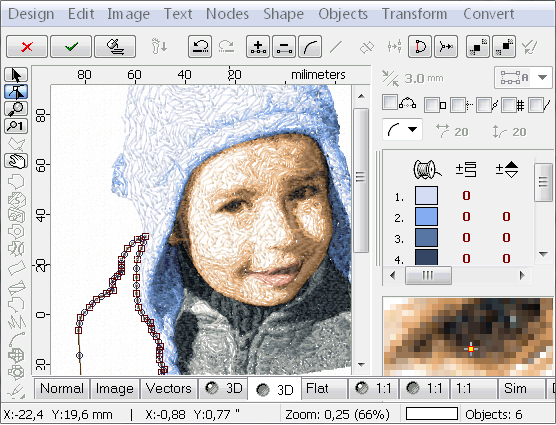Ideal Digitizing for Embroidery: Improve Your Projects
Wiki Article
Discover Various Kinds Of Embroidery Digitizing Techniques
Embroidery digitizing has actually developed considerably over the years, supplying a myriad of strategies to bring designs to life in the digital world. The world prolongs to much more sophisticated strategies like photorealistic needlework digitizing and the interesting world of 3D embroidery digitizing.Traditional Hand Needlework Digitizing
Conventional hand needlework digitizing includes the procedure of converting complex hand-stitched layouts right into electronic styles for device needlework. This method calls for proficient artisans to diligently evaluate the handmade style and then make use of specialized software application to recreate it in a digital layout. Each stitch, color, and information should be meticulously equated to make sure that the significance of the initial hand needlework is maintained in the electronic version.One of the vital difficulties of conventional hand embroidery digitizing is capturing the intricacies and nuances of the handmade style. Digitizing for Embroidery. Artisans have to have a deep understanding of various needlework methods, such as satin stitch, chain stitch, and French knots, to accurately replicate these techniques in the digital world. Additionally, they require to have a keen eye for information to make sure that the digital layout preserves the same level of creativity and workmanship as the initial hand-stitched item
Punching Method
To seamlessly shift from standard hand needlework digitizing to the boxing method, artisans should currently concentrate on transforming the intricate electronic layouts into instructions that needlework devices can translate. The punching technique involves using specialized software application to develop digital documents which contain commands for the needlework maker to follow. This process requires a deep understanding of not just the layout itself yet likewise the capacities and restrictions of the embroidery device.
Auto-Digitizing Software Program Programs
Embroidery digitizing has been changed by the arrival of auto-digitizing software application, supplying craftsmens with innovative tools to convert electronic styles into needlework device guidelines successfully. Auto-digitizing software application make use of algorithms to evaluate digital pictures or vector data and create embroidery layouts automatically. These programs allow for quick and precise conversion of complex layouts right into stitch patterns, conserving effort and time for embroiderers.
One of the crucial benefits of auto-digitizing software application is its easy to use interface, making it available to both beginners and seasoned digitizers. These programs often consist of attributes such as stitch editing devices, string shade matching, and the capacity to preview the last stitched layout. In addition, auto-digitizing software can manage intricate designs with several shades and elaborate information, generating top quality needlework documents appropriate for different clothing and fabric jobs.
While auto-digitizing software program supplies ease and performance, it is important for users to understand the constraints of automated important site digitizing. Fine-tuning and hands-on adjustments might still be required to achieve the desired needlework quality, particularly when handling elaborate or distinct layouts. By leveraging the abilities of auto-digitizing software application alongside hand-operated digitizing techniques, artisans can enhance their needlework digitizing process and produce stunning embroidered items.
Photorealistic Embroidery Digitizing
Utilizing sophisticated electronic imaging methods, accomplishing photorealistic results in needlework digitizing has come to be an in-demand ability amongst modern artisans. This method involves converting high-resolution photos right into elaborate stitch patterns that closely simulate the initial style, resulting in embroidery pieces that display realistic information and depth.To achieve photorealistic needlework digitizing, craftsmens need to possess a keen eye for detail and an extensive understanding of just how various stitch types and thickness can influence the final result. By very carefully mapping out each shade and color in the image, embroiderers can create a digital data that guides the needlework device to duplicate the subtleties of the initial picture properly.
Photorealistic needlework digitizing is specifically preferred in creating custom-made designs for garments, home design, and art items where catching the significance of a photo or art work is vital. This technique allows artisans to change memories, landscapes, pictures, and elaborate artwork right into spectacular stitched work of arts that showcase a his explanation mix of traditional craftsmanship and advanced modern technology.
3D Needlework Digitizing
With the development of electronic imaging strategies in achieving photorealistic results in embroidery digitizing, the exploration of 'D Needlework Digitizing' supplies a brand-new measurement to the intricacies of layout duplication. 'D Embroidery Digitizing' refers to the three-dimensional digitizing strategy that adds deepness and texture to embroidery layouts, producing a more reasonable and aesthetically appealing end product. This technique utilizes software application that imitates the result of light and shadow on the needlework design, enhancing its overall aesthetic impact.Among the essential benefits of 'D Embroidery Digitizing' is its capacity to make designs look even more natural and vibrant. By including depth to the embroidery design, the final item appears much more practical and fascinating (Digitizing for Embroidery). Additionally, this method enables for more innovative freedom in style implementation, allowing embroiderers to experiment with different appearances and impacts that were previously challenging to accomplish
Verdict
YOURURL.com
Report this wiki page